Breast Cancer
Breast cancer is the most common type of cancer in the UK. Most women diagnosed with breast cancer are over the age of 50, but younger women can also get breast cancer. About 1 in 8 women are diagnosed with breast cancer during their lifetime.
There's a good chance of recovery if it's detected at an early stage. For this reason it's vital that women check their breasts regularly for any changes. In rare cases, men can also be diagnosed with breast cancer. Find out more about breast cancer in men.
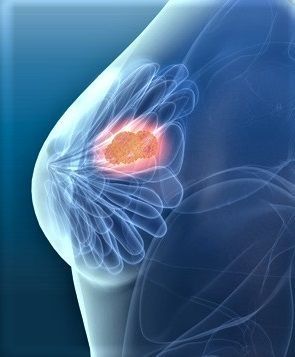
Symptoms of Breast Cancer
Breast cancer can have several symptoms, but the first noticeable symptom is usually a lump or area of thickened breast tissue. Most breast lumps are not cancerous, but it's always best to have them checked by a doctor.
You should also see a GP if you notice any of these symptoms:
- a change in the size or shape of one or both breasts
- discharge from either of your nipples, which may be streaked with blood
- a lump or swelling in either of your armpits
- dimpling on the skin of your breasts
- a rash on or around your nipple
- a change in the appearance of your nipple, such as becoming sunken into your breast
- Breast pain is not usually a symptom of breast cancer.
Causes of Breast Cancer
The exact causes of breast cancer are not fully understood. However, there are certain factors known to increase the risk of breast cancer.
These include:
- age – the risk increases as you get older
- a family history of breast cancer
- a previous diagnosis of breast cancer
- a previous non-cancerous (benign) breast lump
- being tall, overweight or obese
- drinking alcohol
Diagnosing Breast Cancer
After examining your breasts, a GP may refer you to a specialist breast cancer clinic for further tests.
This might include breast screening (mammography) or taking a small sample of breast tissue to be examined under a microscope (a biopsy).

Types of Breast Cancer
There are several different types of breast cancer, which develop in different parts of the breast. Breast cancer is often divided into either:
- non-invasive breast cancer (carcinoma in situ) – found in the ducts of the breast (ductal carcinoma in situ, or DCIS) which has not spread into the breast tissue surrounding the ducts. Non-invasive breast cancer is usually found during a mammogram and rarely shows as a breast lump.
- invasive breast cancer – where the cancer cells have spread through the lining of the ducts into the surrounding breast tissue. This is the most common type of breast cancer.
Other, less common types of breast cancer include:
- invasive (and pre-invasive) lobular breast cancer
- inflammatory breast cancer
- Paget's disease of the breast
It's possible for breast cancer to spread to other parts of the body, usually through the blood or the axillary lymph nodes. These are small lymphatic glands that filter bacteria and cells from the mammary gland.
If this happens, it's known as secondary, or metastatic, breast cancer.
Breast Cancer Screening
Mammographic screening, where X-ray images of the breast are taken, is the most commonly available way of finding a change in your breast tissue (lesion) at an early stage. However, you should be aware that a mammogram might fail to detect some breast cancers.
It might also increase your chances of having extra tests and interventions, including surgery, even if you're not affected by breast cancer.
Women with a higher-than-average risk of developing breast cancer may be offered screening and genetic testing for the condition.
As the risk of breast cancer increases with age, all women who are 50 to 70 years old are invited for breast cancer screening every 3 years.
Women over the age of 70 are also entitled to screening and can arrange an appointment through their GP or local screening unit.
The National Health Service (NHS) in United Kingdom is in the process of extending the programme as a trial, offering screening to some women aged 47 to 73.
Treating Breast Cancer
If cancer is detected at an early stage, it can be treated before it spreads to other parts of the body. Breast cancer is treated using a combination of:
- surgery
- chemotherapy
- radiotherapy
Surgery is usually the first type of treatment you'll have, followed by chemotherapy or radiotherapy or, in some cases, hormone or targeted treatments.
The type of surgery and the treatment you have afterwards will depend on the type of breast cancer you have. Your doctor should discuss the best treatment plan with you.
In a small proportion of women, breast cancer is discovered after it's spread to other parts of the body (metastatic breast cancer).
Secondary cancer, also called advanced or metastatic cancer, is not curable, so the aim of treatment is to relieve symptoms.
Living with Breast Cancer
Being diagnosed with breast cancer can affect daily life in many ways, depending on what stage it's at and the treatment you will have.
How people cope with the diagnosis and treatment varies from person to person. There are several forms of support available, if you need it.
Forms of support may include:
- family and friends, who can be a powerful support system
- communicating with other people in the same situation
- finding out as much as possible about your condition
- not trying to do too much or overexerting yourself
- making time for yourself
- Find out more about living with breast cancer.
Preventing Breast Cancer
As the causes of breast cancer are not fully understood, at the moment it's not possible to know if it can be prevented. If you have an increased risk of developing the condition, some treatments are available to reduce your risk.
Studies have looked at the link between breast cancer and diet. Although there are no definite conclusions, there are benefits for women who:
- maintain a healthy weight
- exercise regularly
- have a low intake of saturated fat
- do not drink alcohol
It's been suggested that regular exercise can reduce your risk of breast cancer by almost as much as a third. Regular exercise and a healthy lifestyle can also improve the outlook for people affected by breast cancer.
If you've been through the menopause, it's particularly important that you try to get to, and maintain, a healthy weight.
This is because being overweight or obese causes more oestrogen to be produced, which can increase the risk of breast cancer
Read and find more at Breast cancer standard treatment by Zdenko Kos Foundation
Paget's disease of the Nipple
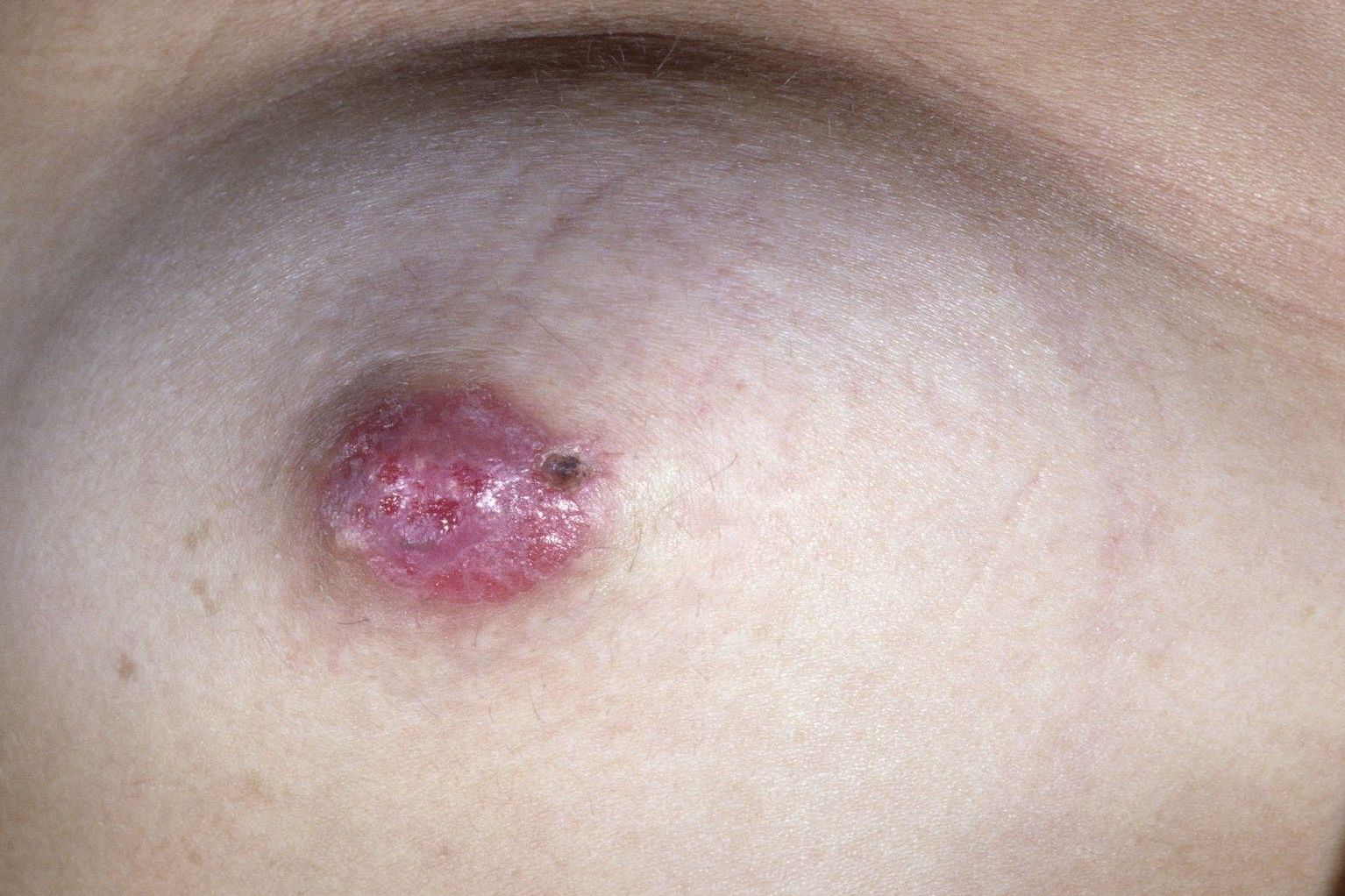
Paget's disease of the nipple, also known as Paget's disease of the breast, is a rare condition associated with breast cancer. It causes eczema-like changes to the skin of the nipple and the area of darker skin surrounding the nipple (areola). It's usually a sign of breast cancer in the tissue behind the nipple.
About 1 to 4% of women with breast cancer have Paget's disease of the nipple. It can also affect men, but this is extremely rare.
The term Paget's disease of the nipple is used to distinguish the condition from Paget's disease of the bone (where bones become weak and deformed).
BREAST CANCER DATA Period 2019 -2024
Hospital Trials and Treatment with our NEW Medication
BREAST CANCER DATA Period 2019-2024
Mortality in EU 2019-2024: 107,298; (EU hospitals Standard Treatments)
Mortality in the UK 2019-2024: 18,882 (UK hospitals Standard Treatments)
Result by Starting using our New Medication/Treatment
(Testing period 2019-2024 all age groups):
Tested patients in UK, Switzerland, Germany and Italy: 428,166
Fully recovered: 21%
Recovered (No treatments needed for period of 2 years, monitoring every 6 months): 31%
Partially Recovered (Further treatments needed as precaution after 3-6months passed): 27%
Unknown Recovery/ Non-recovery: 16%
Deaths in total: Less than 5% (The highest % in the group 66-90).

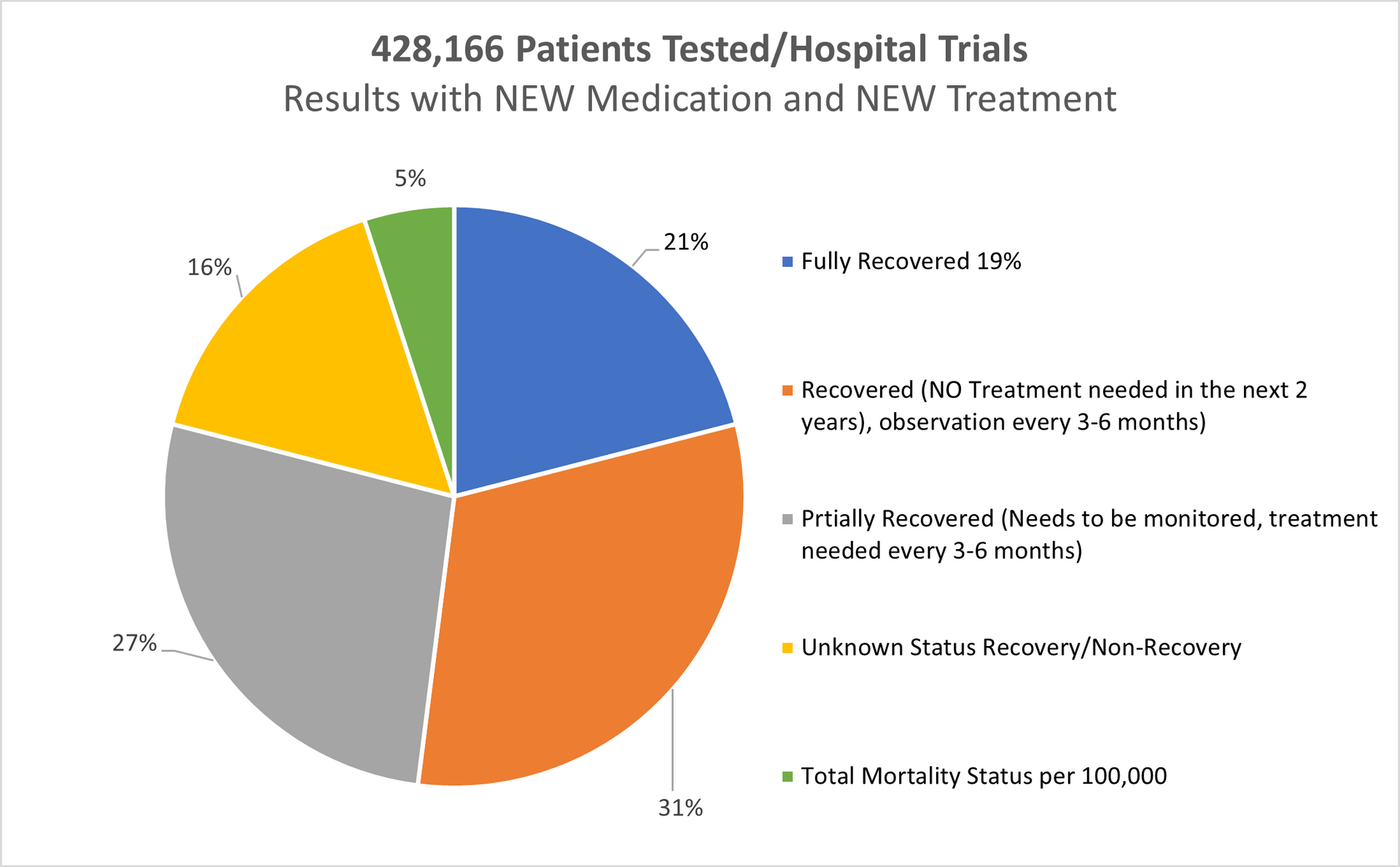
REFERENCES TO THE DATA ABOVE (Period 2019-2024):
Age Gap: The youngest person was not even 16 years of age
The oldest person was over 90 years of age
Gender:
Female: 428,150 of 428,166
Male: 16 of 428,166
Age group 16-25 > 2.3%
Age group 26-45 > 19.8%
Age group 46-65 > 36.3%
Age group 66-90 > 41.6%
-----------------------------
Total: 100%
=====================
Methods:
Old Methods meaning the STANDARD METHODS used by the hospital on a daily basis for the last minimum 5 years in Europe and in the United Kingdom.
New Methods meaning our NEW MEDICATION/TREATMENT with which we came out after over 14 years of research and tests.
New Methods Combine meaning our NEW MEDICATION/TREATMENT COMBINED in double parallel treatment > NEW MEDICATION and different way of treatment combined with chemotherapy or combined with radiotherapy or combined with chemo and radiotherapy.
Separately we tested our NEW MEDICATION combined with "OLD" methods used by the hospitals in Europe and in the United Kingdom however, the final readings cannot be 100 percent accurate and cannot be as such used for whatever comparison.
Mortality:
In the Europe 2019-2024 > 17.1%
In the United Kingdom 2019-2024 > 13.6%
With our NEW Medication/Treatment in Europe & United Kingdom 2019-2024 > Less than 5%.
The % of "Unknown Recovery / Non-Recovery" went up (2018/23 was 15%) to 16% mainly in the age group 46-65 which we believe has increased due to usage of control drugs or heavily drinking and smoking. This group is now monitored separately.
There is an increase of mortality in Europe for 4.9% while in the UK mortality went up by 1.8%.
All patients being chosen randomly what also might be the point of under 5% mortality rate.
OUR RESEARCH and MORTALITY DATABASE 2019-2024
Cancer is one of the biggest health challenges worldwide. Since starting the research in 2011/12, the percentage of all deaths from cancer has risen from 9.6% in 2011 to 14.9% 10 years later; in the last 5 years this has risen again to where we now have 16.2% of all deaths recorded as cancer deaths.
Taking into consideration that in the period 2019-2024 the average European and the United Kingdom population was 760.3 million, an average 4,880,664 new cases were reported yearly during the same period. This is an ASR of 280, and a cumulative risk of 29.8%.
Breast, Colorectum, and Lung cancers were the most common cancers across both sexes.
The male population in this period, some 370.2 million, recorded an average of 2,482,117 new cancer cases per year; an ASR of 321.4 per 100,000 and a cumulative risk of 33.1%.
The top 3 most common cancers among males were Prostate, Lung, and Colorectum cancer.
The female population in this period, some 390.1 million, recorded an average 2,398,547 new cancer cases per year; an ASR of 258.6 and a cumulative risk of 26.5%.
The top 3 most common cancers in females were Breast, Colorectum, and Lung cancer.
A significant point with cancer in the female population was the drop in lung cancer to 3rd place, with colorectum cancer overtaking the 2nd place.
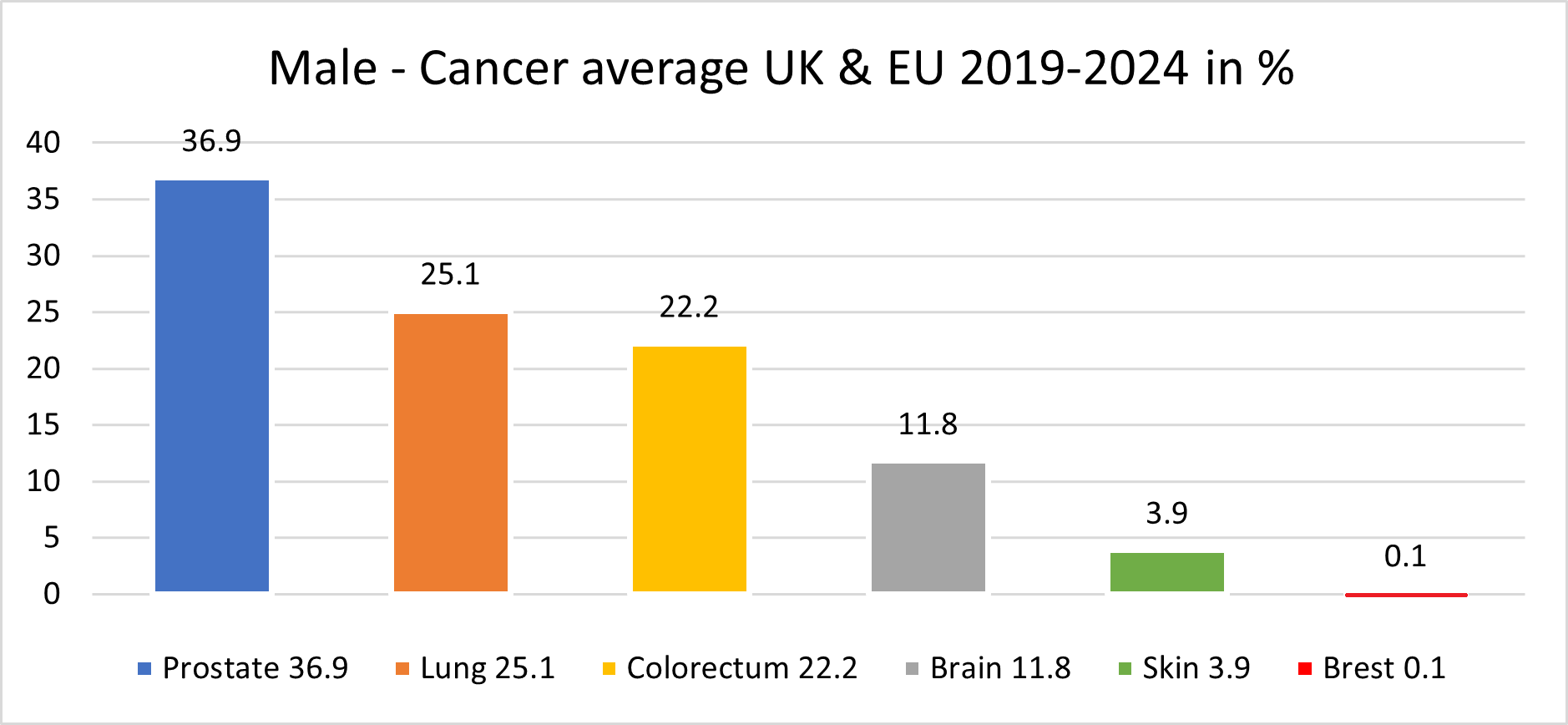
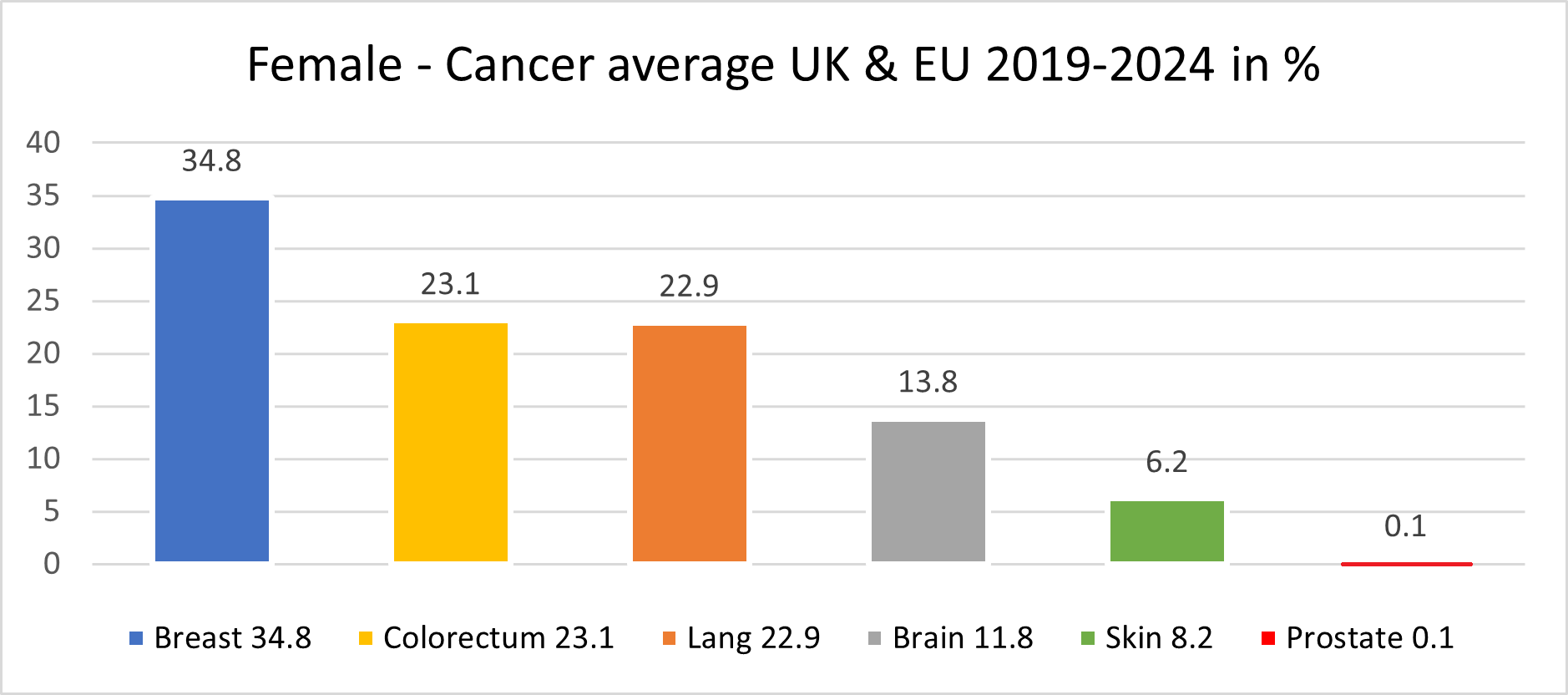
Our mortality database is a collection of death registration data which includes cause of death information from member states; we use only the data which has been properly coded to the International Classification of Diseases (ICD).
What has also changed in recent years is the age of the death rate. This had declined over time in several countries due to life improvements, early diagnoses, medical advances, and a general reduction in risk factors like smoking and even drinking. However, there is a worrying emerging trend with rates of cancer in the population group aged up to 16.
This is rising well over expectations, especially in the United Kingdom, Spain and France.
BREAST CANCER DATA Period 2018 -2023
Hospital Trials and Treatment with our NEW Medication
Breast Cancer Data
Mortality in EU 2018-2023: 222,025; Mortality in UK 2018-2023: 42,836 (EU & UK Standard Treatments)
Result by Starting using our New Medication/ Treatment
(Testing period 2018-2023 all age groups):
Tested patients in UK, Switzerland, Germany and Italy: 388,639
Fully Recovered: 23%
Recovered (No further treatments needed for period of next couple of years): 28%
Partially Recovered (Further treatments needed as precaution after 6months passed):30%
Unknown Recovery/ Non-recovery: 15%
Deaths in total: 4% (Mostly people age 65-88).


REFERENCES TO THE DATA ABOVE:
Age Gap:
The youngest person was of 18 years of age
The oldest person was well over 88 years of age
Gender:
Female: 388,625 of 388,639
Male: 14 of 388,639
- % of age group 18-25 was 4.9%
- % of age group 26-45 was 32.2%
- % of age group 46-65 was 43.7%
- % of age group 66-88 was 19.2%
Methods:
Old Methods meaning the standard methods used by hospital on daily basis for last minimum 5 years in EU and in the UK.
New Methods meaning our medication/treatment with which we came out after over 12 years of research and test.
New Methods combine meaning our medication/treatment combined in double parallel treatment > new medication and different way of treatment
Separate there are also results of our new medication/treatment combined with "old" methods however the final readings cannot be 100 percent accurate and cannot be as such used for whatever compares.
Mortality:
In the Europe 2018-2023 > 15.1%
In the United Kingdom 2018-2023 > 10.4%
With our medication/treatment in Europe & United Kingdom 2018-2023 > Just above 4%.
The % of "Unknown Recovery / Non-Recovery" nearly the same (2017/22 > 15%).
There is increase of mortality in Europe for 2.9% while in UK mortality gone up by 1.2%.
All patients being chosen randomly.
